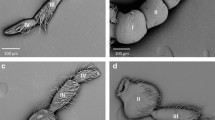Summary
On the antennulae ofLeptestheria dahalacensis (Conchostraca) nearly 600 sensory setae of one type are found. They are gathered in groups of 25–30. The single sensory seta is divided into two parts by the basal bead which is easily visible in the light microscope. The basal bead is the socket of the seta, whose wall is mainly built up by the epicuticle. The terminal pellet closes the tip of the seta. The basal bead is derived from the innermost layer of the epicuticle. 4–10 dendrites each with one receptorcilium innervate the receptor. The receptorcilia stretch through the interior part of the receptor and the basal bead into the exterior part, where they branch. They enter the terminal pellet in a porus, which seems to be a moulting porus. The interior part of the receptor is surrounded by 5 sheath cells. During the premoult it becomes obvious, that the socket of the seta is built by the sheath cell 5, the basal bead by the sheath cell 4 and the shaft by the sheath cell 3. For this the sheath cell 3 is divided into two parts. Between this two parts the newly formed cuticle is invaginated. The sheath cell 2 formes the tip and the sheath cell 1 the cuticular sheath of the new bristle.
Zusammenfassung
Bei dem ConchostracenLeptestheria dahalacensis kommen auf den ersten Antennen etwa 600 gleich aussehende Sinneshaare vor, die in Gruppen von jeweils 25–30 zusammengefaßt sind. Diese Sinneshaare sind in zwei Teile gegliedert, die durch das lichtmikroskopisch gut sichtbare Basalstück (basal bead) voneinander getrennt sind. Dieses bildet die Basis des Haares, dessen Wand im wesentlichen aus Epicuticula besteht. Apikal wird das Haar durch das Endkügelchen (terminal pellet) abgeschlossen. Das Basalstück wird von der untersten Lage der Epicuticula gebildet. Die 4–10 Receptorcilien, die jeweils einzeln ebensovielen Dendriten aufsitzen, ziehen aus dem inneren Teil des Rezeptors, der von insgesamt 5 Hüllzellen umgeben wird, durch das Basalstück, in dem sie stark eingeengt werden und verzweigen sich dann im äußeren Teil des Rezeptors. Sie ziehen bis zum Endkügelchen, in das sie durch einen Porus, den man als Häutungsporus ansprechen kann, eintreten. In der Häutungsvorbereitung wird der Haarbalg von der Hüllzelle 5, das Basalstück von der Hüllzelle 4, der Haarschaft dagegen von der Hüllzelle 3 gebildet. Dabei spaltet sich die Hüllzelle 3 ringspaltförmig auf, so daß in diesem Spalt der neuangelegte Haarschaft handschuhfingerförmig eingestülpt liegt. Die Hüllzelle 2 formt die Spitze des neuen Haares, während die Dendritenscheide von der Hüllzelle 1 abgegeben wird.
Similar content being viewed by others
Literatur
Elofson, R.: The ultrastructure of a chemoreceptor organ in the head of copepod crustaceans. Acta Zool.52, 299–315 (1971)
Ghiradella, H., Cronshaw, J., Case, J.: Fine structure of the aesthetasc hairs ofPagurus hisutiusculus Dana. Protoplasma66, 1–20 (1968a)
Ghiradella, H., Cronshaw, J., Case, J.: Fine structure of the aesthetasc hairs ofCoenobita compressus Edwards. J. Morphol.126, 361–385 (1968b)
Ghiradella, H., Cronshaw, J., Case, J.: Structure of aesthetascs in selected marine and terrestrial decapods: Chemoreceptor morphology and environment. Am. Zool.8, 603–621 (1968c)
Gickelhorn, J., Keller, R.: Neue Methoden der elektiven Vitalfärbung zwecks organspezifischer Differenzierung bei Wirbellosen (über den Bau, die Innervierung und Funktion der Riechstäbe vonDaphnia magna). Z. Wiss. Zool. Abt. A,127, 244–296 (1925)
Guse, G.-W.: Antennal sensilla ofNeomysis integer (Leach). Protoplasma95, 145–161 (1978)
Leydig, F.: Über Geruchs- und Gehörorgane der Krebse und Insekten. Arch. Anat. Physiol. 265–314 (1860)
Rieder, N.: Die Borsten an den Blattbeinen vonTriops cancriformis Bosc. (Crustacea, Notostraca) während der Häutungsvorbereitung. II. Die Ultrastruktur der Borsten vom Typ 2 und 3. Zool. Anz.202, 317–330 (1979)
Risler, H.: Die Sinnesorgane der Antennula vonPorcellio scaber Latr. (Crustacea, Isopoda). Zool. Jahrb. Abt. Anat. Ontog. Tiere98, 29–52 (1977)
Risler, H.: Die Sinnesorgane der Antennula vonLigidium hypnorum (Cuvier) Isopoda, Crustacea). Zool. Jahrb. Abt. Anat. Ontog. Tiere100, 514–541 (1978)
Scourfield, D.J.: The olfactory setae of the Cladocera. J. Quekett Microscopical Club. Ser. II.6, 280–288 (1896)
Scourfield, D.J.: Die sogenannten „Riechstäbchen“ der Cladoceren. Forschgsber. Biol. Stat. Plön12, 340–353 (1905)
Tyson, G.E., Sullivan, M.L.: Antennular sensilla of the brine shrimp,Artemia salina. Biol. Bull.156, 382–392 (1979)
Author information
Authors and Affiliations
Rights and permissions
About this article
Cite this article
Rieder, N., Spaniol, H. Die Rezeptoren an den ersten Antennen vonLeptestheria dahalacensis Rüppel (Crustacea, Conchostraca). Zoomorphologie 95, 169–179 (1980). https://doi.org/10.1007/BF00997910
Received:
Issue Date:
DOI: https://doi.org/10.1007/BF00997910



